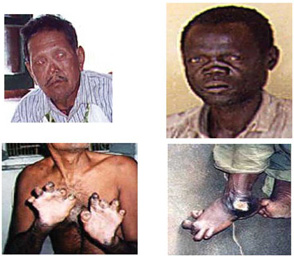What is leprosy?
In Study Session 19 you will also learn about paucibacillary leprosy patients, i.e. those who have few bacteria in their body. Pauci is the Latin word for 'few'.
The sources of infection are untreated multibacillary leprosy patients – patients that have a large number of leprosy bacteria lodged in their body, especially inside the breathing tubes leading to the throat, mouth and nose.
Leprosy affects all age groups and both sexes, with the most affected being the 15–45 years age-group. In the majority of persons infected with leprosy bacteria, the body's natural immunity is able to kill the bacteria. Only about 5% of individuals infected will develop the disease during their lifetime. Because the bacteria grow very slowly in the body, the incubation period varies from six months to 20 years. As the condition develops, the immune system of the body shows a number of inflammatory responses (called leprosy reactions, which you will learn more about in Study Session 19), which can come about in both treated and untreated patients. Damage to nerves is one commonly-seen reaction, including those that control the function of the hands, feet and eyes, and inflammation of the skin is another.
If the disease is untreated, leprosy leads to severe loss of function of organs – one or more disabilities, such as loss of fingers/toes, disfigurement of the nose and blindness (see Figure 18.1).
